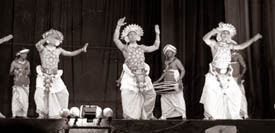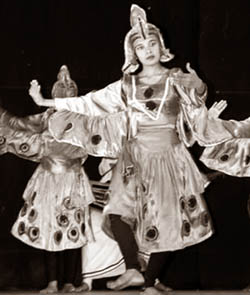|
observer |
|
|
|
|
|
OTHER LINKS |

|

|

|
|
|
|
|
There are three types of traditional dancing in Sri Lanka; Kandyan dancing, Southern or devil dancing and Sabaragamuwa dancing. Today, we will tell you about Kandyan dancing, which is famous all over the world.
Let's see how Kandyan dancing evolved in Sri Lanka. It originated in the period of the Kandyan kings, during the fourth century B.C. According to the legends, the origins of this dance lie in an exorcism ritual known as the Kohomba Kankariya, which was originally performed by Indian shamans (faith healers) who came to Sri Lanka.
According to this legend, the Indian shamans had come to the island upon the request of a king who was suffering from recurring (happening again and again) dreams in which a leopard directed (put out) its tongue towards the king (Divi Dosha).
|
|
This was believed to be due to the black magic worked on by Kuweni, who was the first wife of King Vijaya. After the performing of the Kohomba Kankariya, the king's illness had vanished. So, the natives also adopted this ritual to cure their illnesses.
The Kohomba Kankariya is a Kandyan ritual dance, performed in honour of the God Kohomba, to seek his blessings. There are over 30 ceremonies and over 50 dancers, attired in the traditional Kandyan costume, dance and whirl on a magnificently decorated pavilion. The ritual itself lasts for weeks, and reach its climax on the final night and the following morning.
It was originally performed by people from a specific caste under the Kandyan feudal system. They were attached to the Dalada Maligawa (Temple of the Tooth in Kandy) and had a significant role to play in the Dalada Perahera conducted each year by the temple.
|
|
The aesthetics of the Kandyan dance and its rhythmic vigorous movements and footwork can be really appreciated in its original setting.
Vannam dance is the most popular type of Kandyan dancing. It has 18 sub-types which depict the movement of birds and animals; some of them being the Mayura Vannama - the dance of the peacock, Hanuma Vannama - the dance of the monkey, Gajaga Vannama - the dance of the tusker kings, Kirala Vannama - the dance of the crying Kirala bird, Ukusa Vannama - the dance of the eagle and Sinharaja Vannama - the dance of the tortoise and lion. Earedi Vannama - the dance of the soldier is another vannam.
Originally, vannam had been a kind of recitation. Each style differs from the other depending on the dress, drama, songs, the way of dancing and the movement of hands, legs and fingers. Dancers should learn all the 18 vannams before they would be gifted with the Ves costume.
The Kandyan dance is traditionally performed to percussion instruments. The most common drum used is the Geta Beraya, which is used only in Kandyan dancing. To assist the dancer to keep to the rhythm, a small pair of cymbals known as the Thalampota is also used. The dancers wear elaborate costumes which include a headdress. The dancer's chest is covered only by a decorative beaded net.
|
|
This costume is known as the Ves costume. The headdress incorporates a metallic front, which makes the dancer look taller than he is. The complete costume also includes anklets that produce a metallic rattle.
As we mentioned earlier, the Esala Perahera is the most significant event where we can see the best of Kandyan dancing. Once a year, the Sacred Tooth Relic of the Buddha is brought out of its enshrined place and carried along the streets of Kandy, so that the public can pay homage to it.
The ceremonial procession streams along the streets for 10 nights. The traditional Kandyan dancers, attired in frilled costumes and glistening beads and breast plates, dance, skip and whirl to the drum beats in this perahera which accompany the Tooth Relic.
Generally, Kandyan dances are performed only by male dancers, but recently, female dancers have also worn the ves costume. However, there is no definite ves costume for women.We hope to tell you about the other two types of dancing as well, in our next editions.













